Geoffrey Pettet
An Online Approach to Solve the Dynamic Vehicle Routing Problem with Stochastic Trip Requests for Paratransit Services
Mar 31, 2022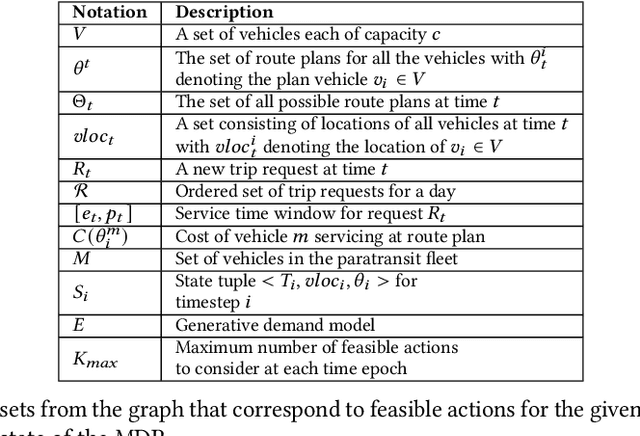

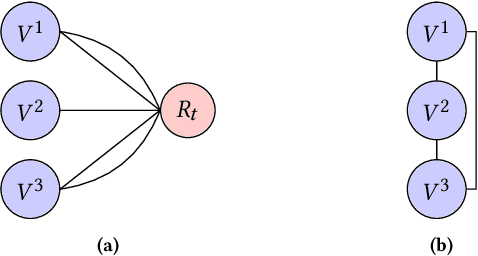
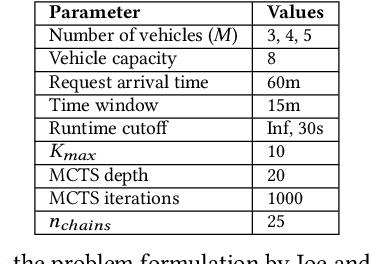
Abstract:Many transit agencies operating paratransit and microtransit services have to respond to trip requests that arrive in real-time, which entails solving hard combinatorial and sequential decision-making problems under uncertainty. To avoid decisions that lead to significant inefficiency in the long term, vehicles should be allocated to requests by optimizing a non-myopic utility function or by batching requests together and optimizing a myopic utility function. While the former approach is typically offline, the latter can be performed online. We point out two major issues with such approaches when applied to paratransit services in practice. First, it is difficult to batch paratransit requests together as they are temporally sparse. Second, the environment in which transit agencies operate changes dynamically (e.g., traffic conditions), causing estimates that are learned offline to become stale. To address these challenges, we propose a fully online approach to solve the dynamic vehicle routing problem (DVRP) with time windows and stochastic trip requests that is robust to changing environmental dynamics by construction. We focus on scenarios where requests are relatively sparse - our problem is motivated by applications to paratransit services. We formulate DVRP as a Markov decision process and use Monte Carlo tree search to evaluate actions for any given state. Accounting for stochastic requests while optimizing a non-myopic utility function is computationally challenging; indeed, the action space for such a problem is intractably large in practice. To tackle the large action space, we leverage the structure of the problem to design heuristics that can sample promising actions for the tree search. Our experiments using real-world data from our partner agency show that the proposed approach outperforms existing state-of-the-art approaches both in terms of performance and robustness.
Designing Decision Support Systems for Emergency Response: Challenges and Opportunities
Mar 13, 2022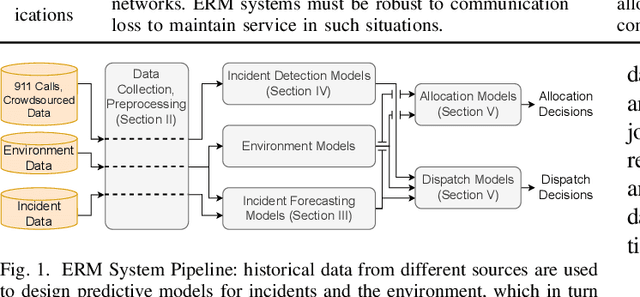

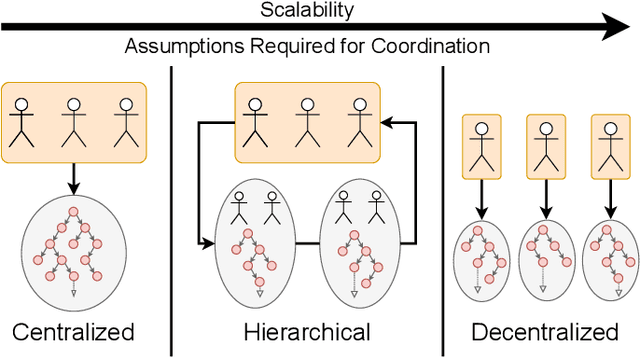
Abstract:Designing effective emergency response management (ERM) systems to respond to incidents such as road accidents is a major problem faced by communities. In addition to responding to frequent incidents each day (about 240 million emergency medical services calls and over 5 million road accidents in the US each year), these systems also support response during natural hazards. Recently, there has been a consistent interest in building decision support and optimization tools that can help emergency responders provide more efficient and effective response. This includes a number of principled subsystems that implement early incident detection, incident likelihood forecasting and strategic resource allocation and dispatch policies. In this paper, we highlight the key challenges and provide an overview of the approach developed by our team in collaboration with our community partners.
Decision Making in Non-Stationary Environments with Policy-Augmented Monte Carlo Tree Search
Feb 25, 2022
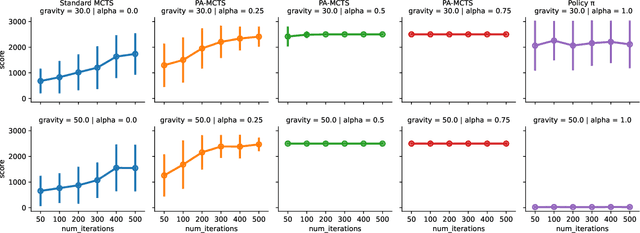
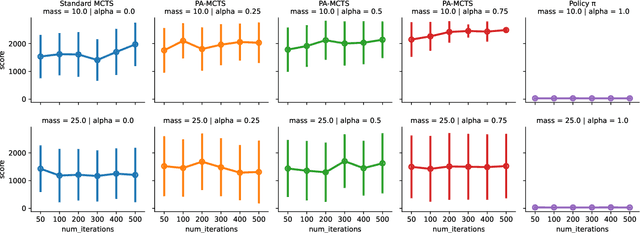

Abstract:Decision-making under uncertainty (DMU) is present in many important problems. An open challenge is DMU in non-stationary environments, where the dynamics of the environment can change over time. Reinforcement Learning (RL), a popular approach for DMU problems, learns a policy by interacting with a model of the environment offline. Unfortunately, if the environment changes the policy can become stale and take sub-optimal actions, and relearning the policy for the updated environment takes time and computational effort. An alternative is online planning approaches such as Monte Carlo Tree Search (MCTS), which perform their computation at decision time. Given the current environment, MCTS plans using high-fidelity models to determine promising action trajectories. These models can be updated as soon as environmental changes are detected to immediately incorporate them into decision making. However, MCTS's convergence can be slow for domains with large state-action spaces. In this paper, we present a novel hybrid decision-making approach that combines the strengths of RL and planning while mitigating their weaknesses. Our approach, called Policy Augmented MCTS (PA-MCTS), integrates a policy's actin-value estimates into MCTS, using the estimates to seed the action trajectories favored by the search. We hypothesize that PA-MCTS will converge more quickly than standard MCTS while making better decisions than the policy can make on its own when faced with nonstationary environments. We test our hypothesis by comparing PA-MCTS with pure MCTS and an RL agent applied to the classical CartPole environment. We find that PC-MCTS can achieve higher cumulative rewards than the policy in isolation under several environmental shifts while converging in significantly fewer iterations than pure MCTS.
Learning Incident Prediction Models Over Large Geographical Areas for Emergency Response Systems
Jun 15, 2021

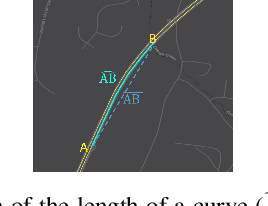

Abstract:Principled decision making in emergency response management necessitates the use of statistical models that predict the spatial-temporal likelihood of incident occurrence. These statistical models are then used for proactive stationing which allocates first responders across the spatial area in order to reduce overall response time. Traditional methods that simply aggregate past incidents over space and time fail to make useful short-term predictions when the spatial region is large and focused on fine-grained spatial entities like interstate highway networks. This is partially due to the sparsity of incidents with respect to the area in consideration. Further, accidents are affected by several covariates, and collecting, cleaning, and managing multiple streams of data from various sources is challenging for large spatial areas. In this paper, we highlight how this problem is being solved for the state of Tennessee, a state in the USA with a total area of over 100,000 sq. km. Our pipeline, based on a combination of synthetic resampling, non-spatial clustering, and learning from data can efficiently forecast the spatial and temporal dynamics of accident occurrence, even under sparse conditions. In the paper, we describe our pipeline that uses data related to roadway geometry, weather, historical accidents, and real-time traffic congestion to aid accident forecasting. To understand how our forecasting model can affect allocation and dispatch, we improve upon a classical resource allocation approach. Experimental results show that our approach can significantly reduce response times in the field in comparison with current approaches followed by first responders.
Hierarchical Planning for Resource Allocation in Emergency Response Systems
Dec 24, 2020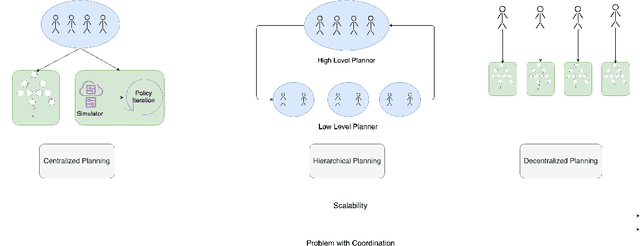
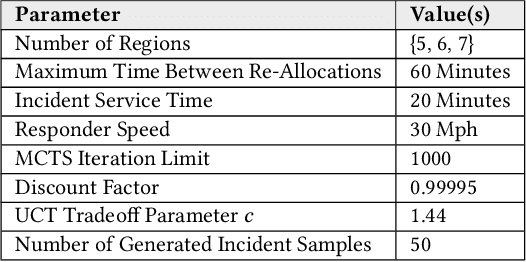
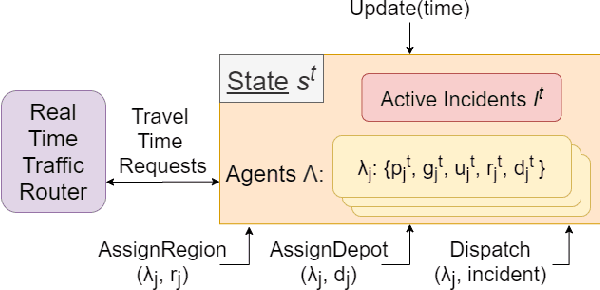
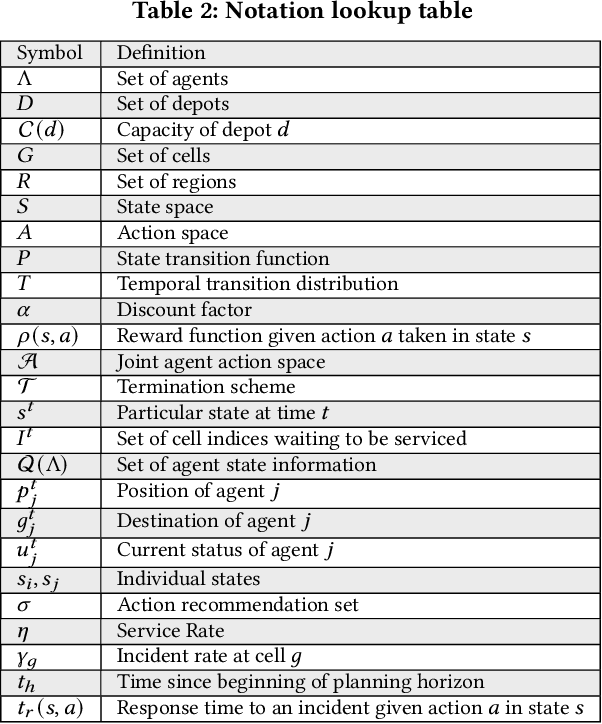
Abstract:A classical problem in city-scale cyber-physical systems (CPS) is resource allocation under uncertainty. Spatial-temporal allocation of resources is optimized to allocate electric scooters across urban areas, place charging stations for vehicles, and design efficient on-demand transit. Typically, such problems are modeled as Markov (or semi-Markov) decision processes. While online, offline, and decentralized methodologies have been used to tackle such problems, none of the approaches scale well for large-scale decision problems. We create a general approach to hierarchical planning that leverages structure in city-level CPS problems to tackle resource allocation under uncertainty. We use emergency response as a case study and show how a large resource allocation problem can be split into smaller problems. We then create a principled framework for solving the smaller problems and tackling the interaction between them. Finally, we use real-world data from a major metropolitan area in the United States to validate our approach. Our experiments show that the proposed approach outperforms state-of-the-art approaches used in the field of emergency response.
Designing Emergency Response Pipelines : Lessons and Challenges
Oct 15, 2020Abstract:Emergency response to incidents such as accidents, crimes, and fires is a major problem faced by communities. Emergency response management comprises of several stages and sub-problems like forecasting, resource allocation, and dispatch. The design of principled approaches to tackle each problem is necessary to create efficient emergency response management (ERM) pipelines. Over the last six years, we have worked with several first responder organizations to design ERM pipelines. In this paper, we highlight some of the challenges that we have identified and lessons that we have learned through our experience in this domain. Such challenges are particularly relevant for practitioners and researchers, and are important considerations even in the design of response strategies to mitigate disasters like floods and earthquakes.
A Review of Emergency Incident Prediction, Resource Allocation and Dispatch Models
Jul 03, 2020
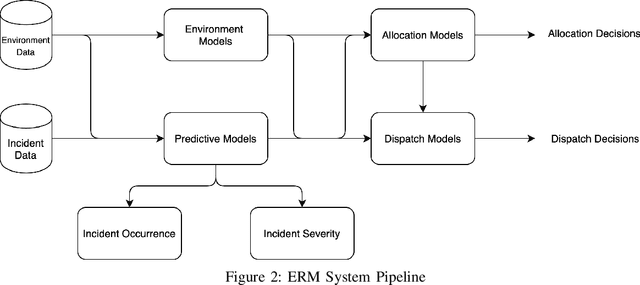
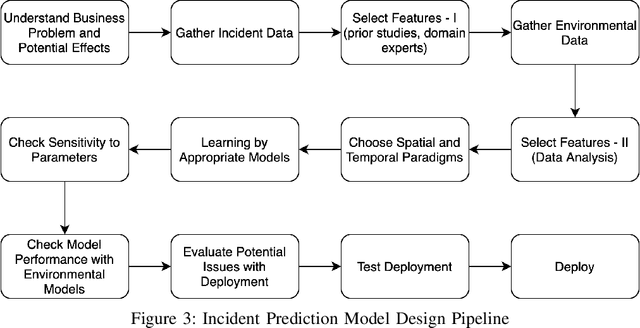
Abstract:Emergency response to incidents such as roadway accidents is one of the most pressing problems faced by communities across the globe. In the last fifty years, researchers have developed statistical, analytical, and algorithmic approaches for designing emergency response management (ERM) systems. In this survey, we present models for incident prediction, resource allocation, and dispatch concerning urban emergency incidents like roadway accidents and crashes. We highlight the strengths and weaknesses of prior work in this domain and explore the similarities and differences between different incident types. Finally, we present future research directions. To the best of our knowledge, our work is the first comprehensive survey that explores the entirety of ERM systems.
On Algorithmic Decision Procedures in Emergency Response Systems in Smart and Connected Communities
Feb 27, 2020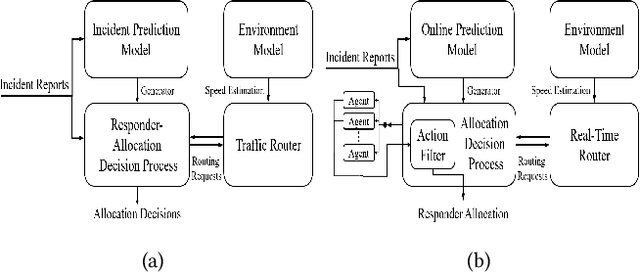
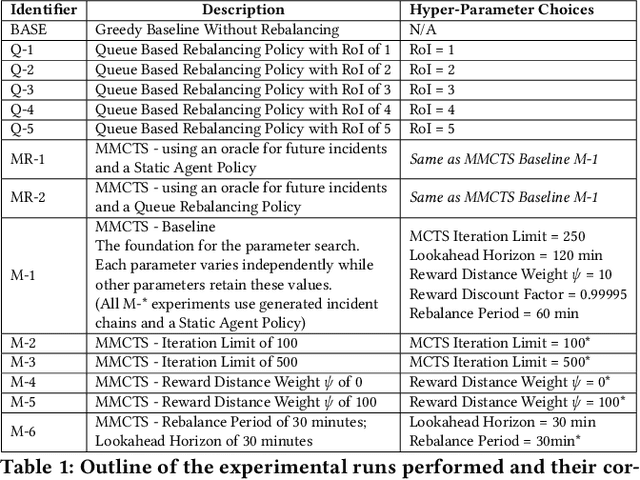
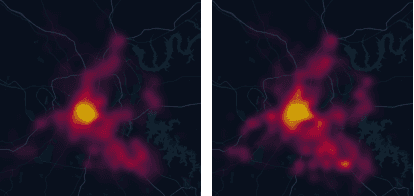
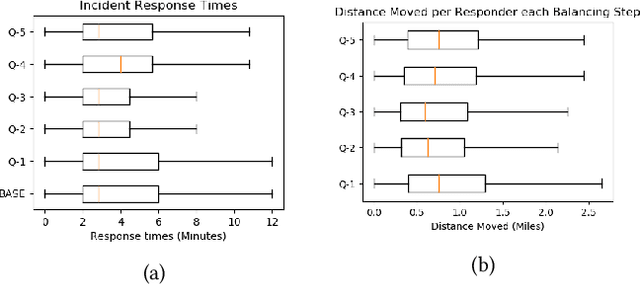
Abstract:Emergency Response Management (ERM) is a critical problem faced by communities across the globe. Despite its importance, it is common for ERM systems to follow myopic and straight-forward decision policies in the real world. Principled approaches to aid decision-making under uncertainty have been explored in this context but have failed to be accepted into real systems. We identify a key issue impeding their adoption - algorithmic approaches to emergency response focus on reactive, post-incident dispatching actions, i.e. optimally dispatching a responder after incidents occur. However, the critical nature of emergency response dictates that when an incident occurs, first responders always dispatch the closest available responder to the incident. We argue that the crucial period of planning for ERM systems is not post-incident, but between incidents. However, this is not a trivial planning problem - a major challenge with dynamically balancing the spatial distribution of responders is the complexity of the problem. An orthogonal problem in ERM systems is to plan under limited communication, which is particularly important in disaster scenarios that affect communication networks. We address both the problems by proposing two partially decentralized multi-agent planning algorithms that utilize heuristics and the structure of the dispatch problem. We evaluate our proposed approach using real-world data, and find that in several contexts, dynamic re-balancing the spatial distribution of emergency responders reduces both the average response time as well as its variance.
An Online Decision-Theoretic Pipeline for Responder Dispatch
Feb 21, 2019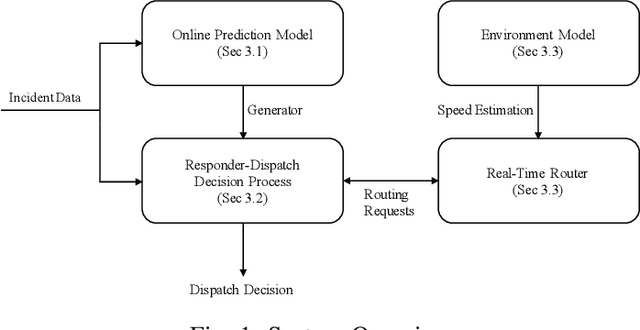
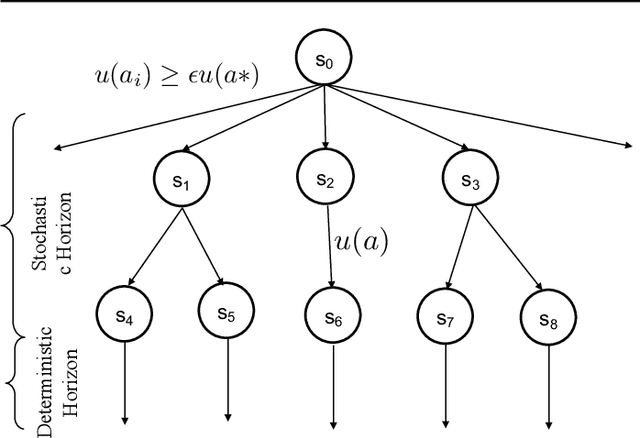
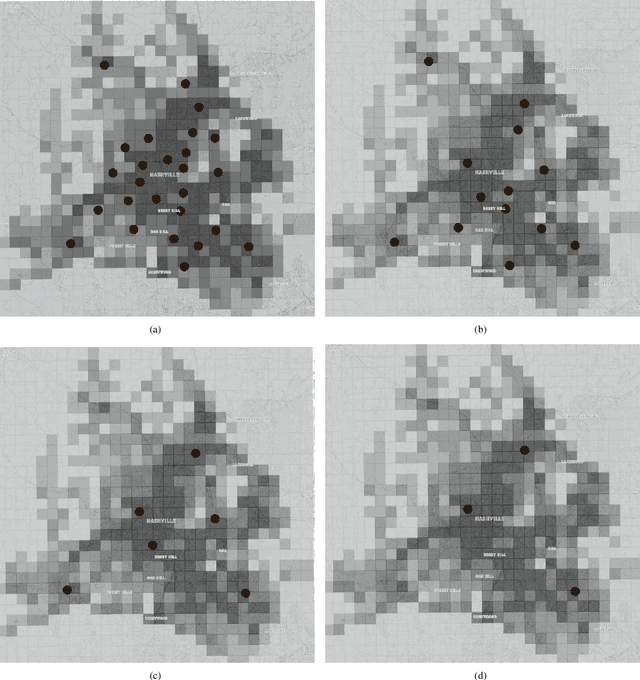
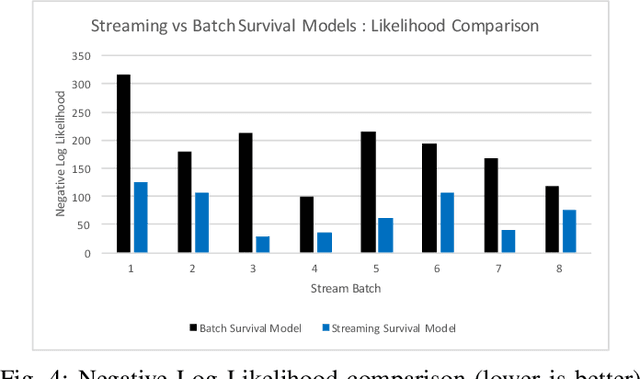
Abstract:The problem of dispatching emergency responders to service traffic accidents, fire, distress calls and crimes plagues urban areas across the globe. While such problems have been extensively looked at, most approaches are offline. Such methodologies fail to capture the dynamically changing environments under which critical emergency response occurs, and therefore, fail to be implemented in practice. Any holistic approach towards creating a pipeline for effective emergency response must also look at other challenges that it subsumes - predicting when and where incidents happen and understanding the changing environmental dynamics. We describe a system that collectively deals with all these problems in an online manner, meaning that the models get updated with streaming data sources. We highlight why such an approach is crucial to the effectiveness of emergency response, and present an algorithmic framework that can compute promising actions for a given decision-theoretic model for responder dispatch. We argue that carefully crafted heuristic measures can balance the trade-off between computational time and the quality of solutions achieved and highlight why such an approach is more scalable and tractable than traditional approaches. We also present an online mechanism for incident prediction, as well as an approach based on recurrent neural networks for learning and predicting environmental features that affect responder dispatch. We compare our methodology with prior state-of-the-art and existing dispatch strategies in the field, which show that our approach results in a reduction in response time with a drastic reduction in computational time.
 Add to Chrome
Add to Chrome Add to Firefox
Add to Firefox Add to Edge
Add to Edge